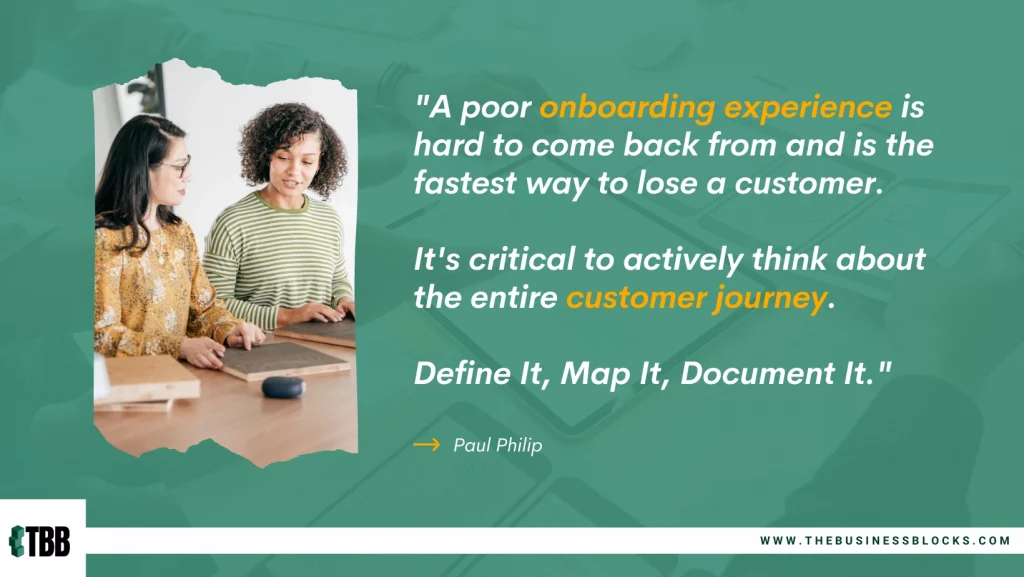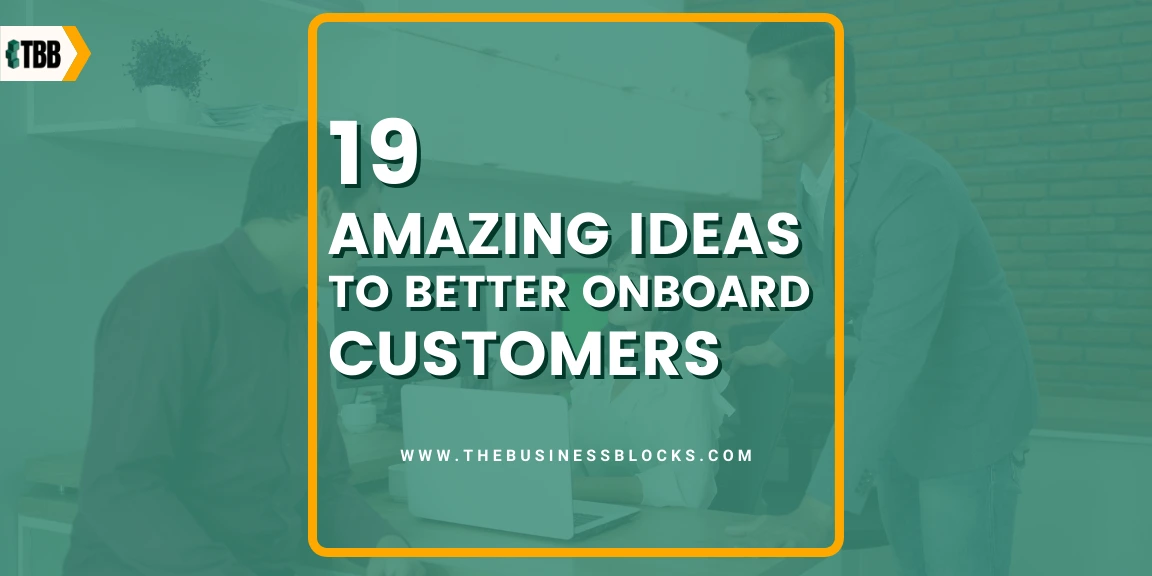Every business, small or large, thrives on repeat customers. Creating a great first impression and providing a fantastic customer experience will make customers want to return and recommend you to other possible customers.
Here are 19 ideas to help you better onboard new customers. Implement as many as you can, and watch your customer base grow.
Have you been looking for Ways to Optimize your Customer Onboarding Experience?
You may have heard that customer onboarding can be a key factor in success and retention, but you’re unsure what strategies will ensure your customers are happy with your product. We’ve put together 19 amazing ideas on how to better onboard customers and also help in ways of how you onboard new clients so you can get the best results from them. These practical tips will improve your process and help increase customer satisfaction.
With our list of 19 amazing ideas, you’ll learn how to design a seamless onboarding process tailored toward meeting individual needs while keeping up engagement levels. Gain insights into the mistakes other companies make when it comes to onboarding, as well as useful tactics such as personalized emails, personal one-on-one checkups, or automated processes that save time yet create remarkable experiences every single time.
Keep reading and unlock the secrets behind successful customer onboarding!
What is Customer Onboarding?
Customer onboarding introduces new customers to your product or service and transitions them from new customers to engaged long-term ones. It usually happens after the customer’s purchase but can also occur when they first sign up for a free trial.
The client onboarding process aims to help the customer get started with using your product or service and ensure that they have a positive experience. It can be done in person, over the phone, or online. The most important thing is that you make it easy for the customer to get started and provide them with everything they need to be successful.
The Customer Onboarding Process
The client onboarding best practices and process aims to transition a customer from a new customer to an engaged, long-term customer. The process generally includes three steps:
1. First, the company must introduce the customer to the product or service. It may include training on using the product or service and demonstrating its value.
2. the company must help the customer use the product or service. You may consider providing customer support during the initial setup and usage phases.
3. Finally, the company must continue to engage with the customer over time to ensure that they remain satisfied with the product or service. They may offer discounts or other incentives for continued use and provide customer service to address any issues.
Benefits of a Good Customer Onboarding
A Precursive study found that 82% of businesses consider onboarding a significant value-added service. But only 74% of companies have dedicated customer onboarding staff. Customer onboarding is a fundamental part of the customer lifecycle and must be executed correctly.

Good customer onboarding can result in several benefits for your business.
Some of the benefits include:
- Increased customer loyalty
Customers who have a positive experience with your product or service are likelier to be loyal to your brand.
- Increased customer satisfaction
Customers who are happy with their purchase will buy from you repeatedly.
- Increased customer lifetime value
Customer lifetime value is the total value a customer brings to your business throughout their relationship with your brand. By providing a smooth and easy onboarding experience, companies can encourage customers to keep using their products or services.
- Reduced churn
Churn is the percentage of customers who stop using your product or service within a certain period. Customers who feel they’ve missed out on something or didn’t get the most value from your product are likelier to churn. But if they feel like they were guided through the product’s features and given some helpful tips, they’re more likely to be satisfied with their experience and less likely to churn.
- Reduced customer inquiries
When a customer is well-onboarded, they have been introduced to your product in a way that makes them feel comfortable and confident using it. They understand how your product works and what its key features are. As a result, they’re less likely to need support from customer service because they can solve most of their problems independently.
On the other hand, if a customer is poorly onboarded, they aren’t given the proper tools or information to use your product effectively. Poor customer onboarding program can lead to frustration and confusion, resulting in more customer inquiries. Effective customer onboarding reduces customer inquiry because it helps customers become self-sufficient users of your product.
19 Best Ways to Onboard a Customer
More and more organizations are waking up to the benefits of a good customer onboarding process, with an increasing number introducing initiatives to better engage with their customers. It’s important to know some business tips and help them feel like they’re part of something, not just a nameless face.
| 1. Make sure you understand the customer’s needs. |
| 2. Help the customer understand what your product or service can do for them. |
| 3. Create a clear and concise onboarding process. |
| 4. Provide the customer with the resources they need to succeed. |
| 5. Follow up with the customer after they’ve completed your onboarding process. |
| 6. Check in with the customer periodically to see how they’re doing. |
| 7. Offer a discount for completing your onboarding process. |
| 8. Send a welcome email to the customer after they’ve signed up. |
| 9. Give the customer a tour of your product or service. |
| 10. Offer live chat support during the customer’s onboarding process. |
| 11. Send helpful tips and tricks to the customer during their onboarding process. |
| 12. Set up a webinar or an in-person meeting to help the customer understand your product or service. |
| 13. Invite the customer to join your social media community. |
| 14. Offer a free trial of your product or service. |
| 15. Give the customer access to exclusive content. |
| 16. Offer a money-back guarantee. |
| 17. Ask the customer for feedback during and after their onboarding process. |
| 18. Celebrate the customer’s success. |
| 19. Thank the customer for being a part of your community. |
1. Make sure you understand the customer’s needs.
Why is it important to understand the customer’s needs? The customer’s needs should be the focus of your onboarding process because they will determine what type of product or service they need.
Your onboarding process should be designed to help the customer achieve their goals as quickly and easily as possible.
2. Help the customer understand what your product or service can do for them.
Customers often have a general idea of what they need but don’t know what your specific product or service can do for them. It’s important to help them understand how your product or service will solve their problem.
3. Create a clear and concise onboarding process.
Your onboarding process should be easy to understand and follow. It should be designed to help the customer quickly become confident in using your product or service.
4. Provide the customer with the resources they need to succeed.
Your onboarding process should include links to helpful resources, such as tutorials, how-to videos, and FAQs. For example, Jotform Academy is an excellent case of onboarding customers in an interactive way that offers users certificates through free training courses.
5. Follow up with the customer after they’ve completed your onboarding process.
Following up with the customer after onboarding ensures they’re still happy with your product or service. This follow-up can be in the form of an email, a phone call, or a survey.
6. Check in with the customer periodically to see how they’re doing.
Even if the customer is happy with your product or service, checking in periodically to see how they’re doing is important. A check-in allows you to offer additional support if needed and helps keep the customer engaged with your brand.
7. Offer a discount for completing your onboarding process.
Offering a discount for completing your onboarding process is a great way to encourage the customer to complete it. It also shows that you’re invested in their success.
8. Send the customer a welcome email after signing up.
A welcome email is a great way to start customer onboarding on the right foot. It’s an opportunity to introduce the customer to your company culture and values and set expectations for what they can expect from the relationship. It also sets the tone for the rest of the onboarding process.
Include links to helpful resources and encourage the customer to reach out if they have any questions. By sending a welcome email, you demonstrate your commitment to your customer – and that’s the fastest way to build a lasting relationship.
Here are a few things to keep in mind when crafting your welcome email:
- Keep it short and sweet – customers are busy and don’t want to read a novel. Get to the point and let them know what they can expect from your product or service.
- Personalize it – use the customer’s name in the subject line and throughout the email. This method will make them feel like you’re talking directly to them, not just sending a generic message.
9. Give the customer a tour of your product or service.
When you bring a new customer on board, giving them a tour of your product or service is important. This will help them understand what they are getting and how to use it. Customer onboarding is about making customers feel comfortable and informed, so take the time to show them around.
10. Offer live chat support during the customer’s onboarding process.
A live chat support feature can be a great addition to your customer onboarding process. This support will allow you to address your customers’ questions or concerns in real time. This feature can help reduce confusion and ensure customers have a positive experience using your product or service.
This support can increase your customers’ chances of a successful onboarding experience.
11. Send helpful tips and tricks to the customer during their onboarding process.
You want your customers to have a smooth, positive experience as they transition to using your product or service. One way to help ensure this is to send helpful tips and tricks during their onboarding process. In this way, they can learn more about your product or service faster and more efficiently and gain confidence and competence as they use it.
Of course, you’ll want to tailor your tips and tricks to the specific needs of your customer base. Some general ideas include providing step-by-step instructions, highlighting key features, and offering helpful resources.
12. Set up a webinar or an in-person meeting to help the customer understand your product or service.
Another way to do this is to set up a webinar or an in-person meeting. This step will allow the customer to ask questions and better understand your offer. In addition, it will enable you to get feedback and ensure the customer is happy with your product or service.
13. Invite the customer to join your social media community.
One of the best ways to encourage customer engagement is to invite them to join your social media community. Using it lets you engage with your customers and inform them about new products, services, and promotions.
In addition, social media provides an excellent platform for customers to interact with each other and provide feedback. Inviting customers to join your social media community can create a more engaged and loyal customer base.
14. Offer a free trial of your product or service.
A free trial is a great way to get new customers interested in your product or service. A free trial allows potential customers to experience your product or service without commitment or risk. This method can be a powerful marketing tool, allowing customers to try before buying.
A free trial can also help build trust and credibility with potential customers. By offering a free trial, you show that you are confident in your product or service and willing to let customers try it out risk-free.
15. Give the customer access to exclusive content.
Another way to better onboard a customer is to give the customer access to exclusive content. This could include helpful guides, behind-the-scenes videos, or early access to new products or features.
By giving the customer something they can’t get anywhere else, you’ll help them better understand your product or service and create a sense of loyalty and exclusivity that will encourage them to stick with your company in the long run.
16. Offer a money-back guarantee.
No one likes to feel like they’ve been duped, especially when they are spending hard-earned cash. That’s why one of the best ways to build customer confidence and loyalty from the outset is to offer a money-back guarantee on your product or service. This process signals that you believe in what you’re selling and are willing to put your money where your mouth is.
In addition, it gives customers a safety net in case they’re not satisfied with what they receive. Of course, you’ll want to set clear parameters for your guarantee, such as limiting it to first-time buyers. But as long as you’re upfront about the details, a money-back guarantee can be another amazing idea to onboard your customers better.
17. Ask the customer for feedback during and after their onboarding process.
Onboarding is essential to the customer journey but doesn’t stop when the sale is made. Your work is just beginning. It’s important to stay in touch during and after their onboarding process to ensure your customers’ success.
How can you do this? Schedule regular check-ins, send surveys, and encourage customers to reach out with any questions or concerns. By ensuring you’re always available and gathering feedback at every opportunity, you can ensure that your customers have a positive experience from start to finish.
18. Celebrate the customer’s success.
Celebrating their success is one simple way to ensure customers have a positive experience. When a customer achieves a goal or reaches a milestone, take the time to recognize their achievement. Send them a congratulatory message, shout out on social media, or offer them a discount on their next purchase.
Celebrating your customers’ successes makes them feel good and strengthens their bond with your company.
19. Thank the customer for being a part of your community.
Whether you’re just starting or have been in business for years, customer onboarding is crucial to maintaining a healthy relationship with your customers. And one of the most important things you can do during the onboarding process is express your gratitude. After all, every customer is an essential part of your community, and without them, your business would not be where it is today.
So take the time to thank them for their support and let them know that you’re excited to have them on board. A simple “thank you” can go a long way toward making your customers feel valued and appreciated.
Common Customer Onboarding Challenges Businesses Face
The right and effective customer onboarding strategy will result in a successful onboarding process. But, most businesses are facing some common challenges while implementing customer onboarding strategies.
Here are some of the most common customer onboarding challenges businesses face:
1. Customer Churn
One of the biggest challenges businesses face during customer onboarding is customer churn. Customer churn is the rate at which customers stop doing business with a company over time. High customer churn rates can negatively impact a company’s revenue and profits.
There are several reasons why customers might churn during the onboarding process. One common reason is a lack of clarity and guidance during the initial stages of the customer journey. Customers may feel confused or overwhelmed by the onboarding process, leading to frustration and a loss of interest in the product or service.
2. Slow Onboarding Process
A slow onboarding process is another major challenge businesses face during customer onboarding. Customers may become frustrated and impatient if the onboarding process is lengthy, time-consuming, and complicated, leading to higher churn rates.
Research has shown that customers expect the onboarding process to be quick, easy, and seamless, with some even expecting to be able to use the product or service immediately. Any delay or inconvenience in this process can be a significant turn-off for customers, leading to a negative first impression and a lack of confidence in the product or service.
3. Lack of Engagement
Another major challenge businesses face during customer onboarding is a lack of engagement from customers. This can happen for various reasons, such as a poorly designed onboarding process, lack of personalization, or failure to communicate the value proposition effectively.
When customers are not engaged during the onboarding process, they may not fully understand the benefits of the product or service the business offers. As a result, they may not use the product or service to its full potential or may even abandon it altogether.
4. Treating all your customers the same
A common mistake businesses make during customer onboarding is treating all customers equally, regardless of their unique needs, preferences, and goals. This one-size-fits-all approach can lead to a lack of engagement from customers, as they may not feel understood or valued by the business.
Moreover, businesses that fail to personalize their onboarding process risk losing customers to their competitors, who are willing to invest in understanding and catering to their customers’ individualized needs. Personalization can include offering customized tutorials, providing tailored offers and incentives, and delivering relevant content based on the customer’s interaction history.
The customer onboarding success and customer retention rates directly relate to how effectively businesses tackle the challenges above. It’s important to note that customer onboarding isn’t a one-time event but a continuous process that requires ongoing attention and improvement.
To avoid providing a poor customer experience, businesses should invest in designing an intuitive and user-friendly onboarding process that caters to the customers’ unique needs and preferences. In addition, businesses can leverage automation and technology to streamline the onboarding process by using customer onboarding software and reduce the time and effort required from the customer. A successful onboarding process is crucial for welcoming a new client into a business, and utilizing a client onboarding questionnaire, along with a comprehensive client onboarding checklist, ensures a seamless corporate customer onboarding experience.
Frequently Asked Questions About Customer Onboarding: 19 Amazing Ideas to Better Onboard Customers
Q: Does a customer feedback process help my onboarding process?
A: Absolutely! Gathering customer feedback throughout the onboarding process can provide valuable insight into areas where your process may need improvement.
Q: What are the best practices for customer onboarding remotely?
A: The best practices for remote customer onboarding are ensuring that your customer service team is available and well-versed, using video conferencing software or virtual whiteboards to explain your products and services, and creating a detailed customer onboarding checklist of tasks that must be completed.
Q: Why Customer onboarding success is important?
A: Customer onboarding success is essential for the customer and your business. It helps to quickly get customers up and running with your services, increasing their satisfaction levels, encouraging continued usage of your products or services, and reducing churn.
Q: How do the customer success team and customer success manager help with onboarding?
A: The customer success team and customer success manager should be an integral part of the onboarding process. They can guide customers throughout the process, answer any questions, help them better understand your services and products, and offer personalized assistance.
Q: How do the customer success team and customer success manager help with onboarding?
A: The customer success team and customer success manager should be an integral part of the onboarding process. They can guide customers throughout the process, answer any questions, help them better understand your services and products, and offer personalized assistance.
Conclusion

Your customer onboarding process is the first impression you make to your customers. It’s important to take the time to design a process that will engage and delight them and provide value from the very beginning.
By taking advantage of these 19 unique ideas, you can create an onboarding experience with your new customers singing your praises and being eager to do business with you again. How has your company improved its customer onboarding process?

